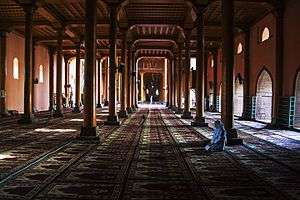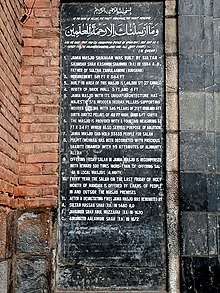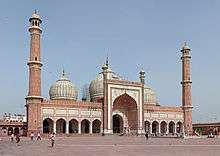Jamia Masjid, Srinagar
Jamia Masjid is a mosque in Srinagar, Jammu and Kashmir, India. Situated at Nowhatta in the middle of the Old City, the Mosque was commissioned by Sultan Sikandar in 1394 CE and completed in 1402 CE,[1] at the behest of Mir Mohammad Hamadani, son of Mir Sayyid Ali Hamadani,[2] and is regarded as one of the most important mosques in Kashmir.[3] The Mosque is located in Downtown which remains a central zone to the religio-political life in Srinagar. Thronged by Muslims every Friday, it is one of the prime tourist attractions of Srinagar.[1]
| Jamia Masjid | |
|---|---|
.jpg) A View of Eastern Entrance | |
| Religion | |
| Affiliation | Islam |
| District | Srinagar |
| Province | Jammu and Kashmir |
| Status | Active |
| Location | |
| Location | Nowhatta, Srinagar |
| Country | India |
| Geographic coordinates | 34.098352°N 74.809180°E |
| Architecture | |
| Type | Mosque |
| Style | Indo-Saracenic |
| Completed | 1402 CE |
| Specifications | |
| Capacity | 33,333 |
| Length | 384 feet (117 m) |
| Width | 381 feet (116 m) |
| Dome(s) | 4 (turrets) |
| Minaret(s) | None |
| Materials | Deodar, Stones, Bricks |
.jpg)
Architecture
The Jamia Masjid is heavily influenced by the Indo-Saracenic style of architecture and has been constructed in the Persian manner, with some similarities to the Buddhist pagodas. The structure occupies a total area of 384 x 381 feet and is quadrangular in shape with four turrets. These are in the middle of each side and covered with pyramidal roofs. All of the turrets are interconnected by spacious halls, with bright yellow poppies lining the mossy brick paths and the entire structure is surrounded by wide lanes on all four sides and has a square garden in the middle. The entrance on the southern side of the Mosque comprises a recessed portico which further leads onto an inner courtyard. This courtyard is based on the traditional Chaar Bagh plan and has a tank in the centre. The entire courtyard is made up of pointed arched, brick arcade.[4] The court which was originally planted with a series of chinars is enclosed by arched liwans (cloisters) covered with two tiered sloping roof.[5]
In History
The Jamia mosque was earlier known as Tarapida temple as it was built by King Tarapida of Kashmir ( 700 CE). It was originally a buddhist temple which got destroyed by Sikandar Butshikhan and converted to mosque using the remains of the temple. It is not only the religion that has attracted the people of the state to the Mosque. The Jamia Masjid has been a hot-bed of raging political discourse on the present turmoil in the state, and the politics that has unfolded in Kashmir has led to curbs and gags on congregations here. Its roots, however, lie deeper in history. The Mosque also became a platform for people to debate and discuss the politics of the Kashmir conflict much earlier before the conflict erupted in Kashmir valley.[5] According to historian Mohammad Ishaq Khan, “Jamia Masjid has primarily played a significant part in imparting religious education. However, with the spread of modern education among Kashmiri Muslims, thanks to the efforts of Mirwaiz Ghulam Rasul Shah, the Masjid began to play a seminal role in the growth of political consciousness. Sheikh Muhammad Abdullah was, in fact, initiated into what I would call the mysteries of Kashmiri Muslim politics at Jamia Masjid by Mirwaiz Muhammad Yusuf Shah.”[6]
Sikh Era (1819-1846 CE)
For 21 years,[5] the Mosque faced closure under the Sikh regime of Maharaja Ranjit Singh beginning in 1819 AD, when the-then Governor, Moti Ram, put curbs on offering prayers in Jamia Masjid.[7] No prayers were offered and no call for prayers was given from the Mosque. It was reopened by Sikh Governor, Ghulam Muhi-ud-Din, in 1843[8] who spent nearly a lakh and a half of rupees on its repair. But for 11 years, rulers allowed prayers only on Fridays. The Mosque would be opened for just few hours on Fridays and closed again.[5]
July 13, 1931

The martyrs of July 13, 1931 were taken to Jamia Masjid after the police opened fire and 22 people were killed and hundreds injured. The bodies of the martyrs were laid in the shrine compound of Khawaja Naqashband Sahab R.A Khawaja Bazar Srinagar where Sheikh Abdullah, Mirwaiz Maulvi Muhammad Yusuf Shah and other leaders started delivering speeches against Maharaja Hari Singh.[5]
Post 1947
Prolonged closure of the Mosque once again came into effect since 2008 when the Amarnath land row erupted. The decision of the Congress-PDP government to prevent people from offering Friday prayers for weeks together led to massive outrage.[6] Ban on religious congregations in 2008 was seen as an attempt to choke the rebellion whose epicentre was the hotbed of separatist leaders, the areas in old city, particularly around Jamia Masjid.[5] During the Mehbooba Mufti led BJP-PDP coalition government, the Mosque was again "locked down for three months in the uprising of 2016 and in 2017 for the first time even Jumat-ul-Vida congregation during Ramadan was not allowed and in 2018 for 16 Fridays, prayers were barred at the Mosque."[9]
Post Revocation of the special status of Jammu and Kashmir via scrapping of the Article 370 of the Constitution of India, Article 35A of the Constitution of India and the introduction of Jammu and Kashmir Reorganisation Act, 2019 on 5 August 2019, the government imposed restrictions on prayers for 136 days [10]
The Complex
On the western and eastern sides, the Mosque is 381 feet (116 m) in length while the northern and southern sides are 384 feet (117 m) long.[11] The inner courtyard measures 375 feet (114 m) x 370 feet (110 m) having a 33 feet (10 m) x 34 feet (10 m) water tank with a fountain flowing in the centre. Thus the space area of the Mosque is 146,000 square feet (13,600 m2). Its walls made of burnt bricks are over 4 feet (1.2 m) thick. The lower portion of the walls is made of rectangular stones. There are three big entrance gates on north, south and eastern sides of the Mosque confronting three turrets standing on lofty columns of deodar wood.[2] The eastern side has a large entrance called the Shah Gate which is covered with a pyramidical roof surmounted by a square open pavilion (brangh) with a spire on top.[5] A total of 378 wooden columns support the roof. Each turret is supported by eight lofty pillars 48 feet (15 m) high and 6 feet (1.8 m) in girth. The mihrab too has a similar turret over it. The remaining interior of the Mosque has 346 columns 21 feet (6.4 m) high and 5 feet (1.5 m) in girth. Initially the roof was covered with birch bark and clay.[2][12] The western wall of the cloister has a mihrab made of black Kashmiri marble which is adorned with beautiful calligraphic work and has engraved on it ninety-nine attributes of Almighty Allah.[4] The Mosque can hold 33,333 persons besides the Imam at a single prayer congregation.[12]

To reach the Mosque roof, the walls of the four turrets have interior stairs in the circular form that end in the lounges of each turret. The city of Srinagar can be viewed from these high turrets. The roof is constructed out of timber and iron bars. The birch bark over the roof is now replaced by corrugated iron sheets. The inner courtyard of the Mosque has a water fountain, that is used for ablution, with four lawns around it decorated with chinar trees.[2] The water tank in the courtyard was originally fed by a water channel known as Lachma Kual.[5]
Reconstructions
The Mosque has been subject to much destruction till date due to the damage caused by fires. The Mosque was partially or completely destroyed by devastating fires thrice but was restored after every disaster.[13] The existing construction was erected by Emperor Aurangzeb Alamgir in 1672 C.E. The reconstructions and major renovations in mosque's history have been conducted by:
- Sultan Sikandar (r. 1389–1413 CE) in 1394 CE (796 AH): The Sultan commissioned the construction of the Mosque in 1394 CE[12] and it was completed in 1402 CE.[1]
- Sultan Hasan Shah (r. 1472–1484 CE) in 1480 CE (885 AH): The first fire that damaged it was in 1479, and the then ruler, Sultan Hasan Shah, immediately began the reconstruction work. He died before the repair work was done, and the task was taken over by Ibrahim Magre, the Commander-in-Chief of Kashmir forces under the rule of Muhammad Shah and Fateh Shah and completed it by 1503 CE.[4][5]
- Jehangir (r. 1605–1627 CE) in 1620 CE (1083 AH): After facing another fatal destruction because of fire during the supremacy of Mughal Emperor Jehangir, the Mosque was re-constructed under an architect-historian based in Kashmir, namely, Malik Haider of Tsodur.[14] The entire repair work took 17 years to complete.[4][5]
- Aurangzeb Aalamgir (r. 1658–1707 CE) in 1672 CE:[12] The third fire that distorted the structure was during the reign of Aurangzeb. It is said that when Aurangzeb heard about the accident, he only inquired if the chinars were safe, for 'the Mosque could be rebuilt in a short time. A full-grown chinar can never be replaced.'[15] He got together all the bricklayers and masons of the city, and Jamia Masjid was restored within three years.[4][5]
Pertinently, during his reign, Sultan Zain-ul-Abidin (r. 1420–1470 CE) extended the Mosque[14] and constructed a turret[16] in the primary structure.[4] The last restoration work was carried out under the reign of Maharaja Pratap Singh (r. 1885-1925 CE). Singh enthusiastically encouraged the reconstruction of the Mosque many times and even offered financial assistance.[5][13] However, all the renovations were carried out to reflect the original architecture and to retain the historic value of the Mosque that it has carried through centuries.[14]
Maintenance
The Jamia Masjid falls under the domain of Anjuman-e-Auqaf, a private enterprise. The caretaker board of the Mosque was constituted in 1975. Major source of revenue comes from the rent of 278 shops (owned by the Auqaf) around the Mosque and other sources of public funding. The revenue is not fixed and varies annually. Before the inception of the Auqaf, income for the Mosque used to come from elite citizens of the State. For the welfare of the Mosque, INTACH has recently taken over the reins of renovation.[5]
Desecration
On December 28, 2018, a group of masked young men stormed into the Mosque with ISIS flags on Friday, after the congregational prayers, when the Mosque was nearly empty. The men were chased away by the devotees present. A video of the incident went viral on the social media the next day. It was reported that after Mirwaiz Umar Farooq delivered the Friday sermon at the Mosque, "a group of masked men barged into the Mosque and rushed to the pulpit where the Mirwaiz delivers the sermon. One of them stood atop the pulpit with his shoes on, shouting slogans." The incident provoked condemnation from the Mosque's management committee as well as separatists. The JRL maintained that, "this was an instance of some elements diverting their just movement by changing its basic nature and character under the pretence of purusing some global agenda."[17][18][19][20] The incident was also condemned by Jamaat-e-Islami,[21] Kashmir Economic Alliance,[22] Muslim League,[23] Lashkar-e-Taiba,[24] Mehbooba Mufti,[25] and Saifuddin Soz,[26] among others.
Observing 'Purification Day' (Yaum-e-Tat'heer) on January 2, 2019, Mirwaiz Umar Farooq led a cleansing drive of the pulpit of the Mosque, where ISIS supporters had waved black flags and also raised slogans in support of the caliphate. The following Friday (January 4, 2019) was observed as a day of honour (Yaum-e-Taqaddus) to reiterate the importance and the sanctity of the Mosque.[27][28][29]
References
- "Jama Masjid Srinagar - Biggest Mosque in Kashmir Valley". Tour My India. Tour My India Pvt. Ltd. Retrieved 9 January 2019.
- "Jamia Masjid Srinagar". Gaffara Kashmir. Archived from the original on 21 July 2017. Retrieved 8 May 2009.
- "Jama Masjid – Srinagar". Kashmir Hills. Retrieved 9 January 2019.
- "Jamia Masjid". Holidify. Retrieved 9 January 2019.
- Handoo, Bilal (29 October 2012). "The Legend Of Jamia Masjid". Kashmir Life.
- Aslam, Faheem. "JAMIA MASJID SIEGE: Moti Ram's legacy revived". Greater Kashmir. G.K. Communications Pvt. Ltd. Retrieved 9 January 2019.
- Bamzai, P. N. K. (1994). Culture and Political History of Kashmir (1st ed.). New Delhi-110002: M D Publications Pvt. Ltd. p. 623. ISBN 81-85880-34-4.CS1 maint: location (link)
- Lawrence, Walter R. (2005). The Valley of Kashmir. 31, Hauz Khas Village, New Delhi-110002: Asian Educational Services. p. 201. ISBN 8120616308.CS1 maint: location (link)
- "Huriyat hits out at Mehbooba, says Jamia locked for three months in her rule in 2016". Greater Kashmir. G.K. Communications Pvt. Ltd. Retrieved 9 January 2019.
- "Prayers Allowed in Srinagar's Jamia Masjid for the First Time in 136 Days". The Wire. Retrieved 15 May 2020.
- "Jama Masjid". Department of Tourism, Jammu and Kashmir. Retrieved 9 January 2019.
- Jahan, S. M. Mukarram (9 January 2019). "Plaque of Jamia Masjid". Wikimedia Commons. Wikimedia. Retrieved 9 January 2019.
- "Jamia Masjid". Srinagar Municipal Corporation. Retrieved 9 January 2019.
- "Jamia Masjid in Kashmir". J&K Tourism Development Corporation. Retrieved 9 January 2019.
- Mohammad, Ghulam (1976). Iqbal, Sheikh Mohammad (ed.). "Jamia Masjid, Srinagar". Jammu & Kashmir State Research Biannual. Srinagar: Department of Libraries, Research, Museums and Archaeology, J&K Govt. I (II): 34.
- Ul Aslam, Viqar (10 June 2017). "Ramadan at Jamia Masjid, Srinagar". Rising Kashmir. Syed Rafi-u-Din Bukhari. Rising Kashmir. Retrieved 9 January 2019.
- Masoodi, Nazir. "Masked Men Storm Into Srinagar's Jamia Masjid, Wave ISIS Flags". NDTV. Retrieved 9 January 2019.
- "Mirwaiz leads rally against IS's desecration of Jamia Masjid in Srinagar". Hindustan Times. 2 January 2019. Retrieved 9 January 2019.
- "Jamia Masjid desecration: JRL holds meeting at Geelani's residence". The Kashmir Walla. 31 December 2018. Retrieved 9 January 2019.
- "Desecration of Jamia Masjid won't be tolerated: Auqaf". Daily Excelsior. 29 December 2018. Retrieved 9 January 2019.
- "Desecration of Jamia Masjid intolerable: Jama'at". Kashmir Reader. 31 December 2018. Retrieved 9 January 2019.
- "Jamia Desecration Issue: KEA Calls For Joint Strategy To Foil Nefarious Designs". Valley Online. 1 January 2019. Retrieved 9 January 2019.
- "Muslim League condemns desecration of Jamia Masjid". Kashmir Reader. 7 January 2019. Retrieved 9 January 2019.
- "LeT condemns desecration of Jamia Masjid". Kashmir Life. Retrieved 9 January 2019.
- "Mehbooba calls Mirwaiz to convey her outrage over Jamia Masjid desecration". Kashmir Life. Retrieved 9 January 2019.
- "Soz condemns desecration of Jamia Masjid". Greater Kashmir. G.K. Communications Pvt. Ltd. Retrieved 9 January 2019.
- "Mirwaiz Heads Drive to Clean Jamia, Says Will Reveal Names of Masked Youth Soon". The Kashmir Walla. 2 January 2019. Retrieved 9 January 2019.
- "Days after IS flags at Jamia, Mirwaiz cleans defiled area". The Tribune. Retrieved 9 January 2019.
- "Mirwaiz Leads Cleansing Of Jamia Pulpit, Vows To Name Masked Men". Kashmir Observer. 2 January 2019. Retrieved 9 January 2019.
| Wikimedia Commons has media related to Jamia Masjid, Srinagar. |

